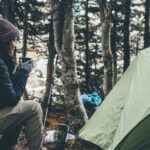Mountaineering tools some might take as a hobby or others take it as a professional carrier/job. But either way in order to get on top of the game, you have to have the proper tools.
Alpinism, sometimes known as mountaineering, is a group of outdoor pursuits that require climbing sizable mountains. Skiing, Ferrata traversing, and classic outdoor climbing are all mountaineering-related activities. Some people also include bouldering, sport climbing, and indoor climbing as variations of mountaineering.
You will get more knowledgeable about each tool and how to utilize it as you gain more mountain climbing experience. However, as a newbie, I found it helpful to become familiar with the names and appearance of these tools. When reading books or articles about mountain climbing, these will be quite helpful. So, let’s climb the list of all the necessary tools or gadgets we need.
- Mountaineering Boots
- Crampons
- Helmets
- Ice Axes
- Rope
- Harness
- Compass/GPS
- Backpacks
- Tents
- Headlamps
- Stoves
1. Mountaineering Boots
The first and foremost thing in mountaineering is boots. Never disregard the value of a decent set of mountaineering boots. They will offer grip, stability, and the ability to fasten crampons for climbing snow and glaciers while traversing rocky terrain. When looking at mountaineering boots, you have two main options: insulated and non-insulated.
2. Crampons
Multiple types of crampons are available. You can choose according to your need. Steel crampons are a popular option for regular mountaineering since they are robust and long-lasting. Although significantly lighter than steel, aluminum crampons are also less sturdy.
Types of tying: One of the three binding styles—strap-on, step-in, or hybrid—is used to secure crampons to boots. The flexible toe and heel bindings of strap-on crampons allow them to be attached to almost any pair of mountaineering boots. The flexible toe and heel bindings of strap-on crampons allow them to be attached to almost any pair of mountaineering boots. The heel levers on hybrid crampons call for boots with grooves or welts on the back.
3. Helmets
You should wear a climbing helmet to prevent any head injuries. And the chances of suffering a brain injury when climbing are probably far higher than you thought. Never use a climbing helmet if you want to be comfortable. They impede your vision and over time can get pretty warm. However, these inconveniences are insignificant in comparison to your safety.
4. Ice Axes
When evaluating the lengths, weights, and shapes of the available ice axes, you should take into account your size and level of exercise. Simply holding an axe at your side with your hand wrapped around the head and the shaft pointing down toward the ground while standing comfortably is a common method for determining the proper length of an axe. When you are standing straight up with your arms at your sides, the axe’s spike should be about halfway up your ankle bone.
5. Rope
Different type of ropes is dynamic, single, twin, static, and double/half rope. Dynamic ropes must be utilized with every rope used for climbing. When loaded, dynamic ropes can lengthen and stretch. This will cushion the blow when a climber falls. Dynamic ropes come in three different varieties: single, twin, and double/half. While twin and double/half ropes must be used in pairs, single ropes can be used as a single strand. Static ropes, in contrast, do not lengthen and stretch. Static ropes are employed in equipment transportation and rescue operations. When moving equipment or injured climbers, you do not want the ropes to strain.
6. Harness
While mountaineering, a regular rock-climbing harness can be used, but a harness made expressly for mountaineering will be more comfortable and practical. A mountaineering harness is frequently made of flat webbing and has low-profile gear loops to keep it lightweight, small, and comfortable while being worn with a pack.
7. Compass/GPS
Some skilled climbers will only require a paper map and compass to navigate—two things that are very necessary for any climb. But for many expeditions, a GPS is the preferred compass. Though the extreme cold you might experience high on a mountain might shorten the life of batteries, be sure to start with fully charged batteries, pack backups, and attempt to keep your device warm by stowing it in a pocket when it’s not in use.
8. Backpacks
Although you might be able to utilize your backpacking pack for mountaineering, mountaineering packs have particular qualities that make them perfect for climbing peaks. To allow for unrestricted arm movement while scrambling, climbing, and handling ropes, the majority of mountaineering packs (also known as climbing packs) feature a thinner, sleeker shape. For summit efforts, many of them also let you “strip down” the pack by taking off the lid, freesheet, and possibly the hip belt.
9. Tents
You will require a shelter to sleep in for mountaineering treks that last more than one day, which is the case for many of them. Although some climbers opt for lightweight bivy sacks, a four-season tent is more frequently used. Your 3-season backpacking tent will function properly in some circumstances, but a 4-season tent is designed to endure strong winds and heavy snow loads, which you may experience at any time of year on some mountains. In comparison to 3-season tents, 4-season tents employ more poles and stronger fabrics to endure extremely unfavorable weather. The flat roof areas where snow can accumulate are eliminated by their circular dome forms.
10. Headlamps
A headlamp is essential whether you’re out for a single day or several. Most summit efforts begin before dawn, so you’ll need a powerful, dependable headlamp to guide you through the night. To get enough light, look for an LED headlamp that has both flood and spot beams and produces at least 100 lumens. Always keep an additional pair of batteries on hand, and think about using lithium batteries instead of alkaline as they can handle frigid conditions better.
11. Stoves
You must choose between a liquid-fuel stove and a canister-fuel stove when limiting the number of camping stoves. When choosing, weight and temperature are two important factors. Considering weight: Canister-fuel stoves will always be lighter than liquid-fuel stoves because of their design. When compared to a liquid-fuel stove with a refillable fuel bottle, the weight advantages can be compensated by the need for more fuel canisters.
Observations about the temperature outside: While mountaineering, you will frequently experience frigid temperatures, and liquid-fuel stoves perform better than canister-fuel stoves in these conditions. Colder temperatures cause the fuel canister’s pressure to drop, which dramatically lowers the stove’s efficiency. To counter this, some canister stoves incorporate pressure regulators.






